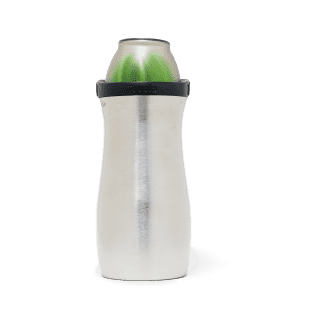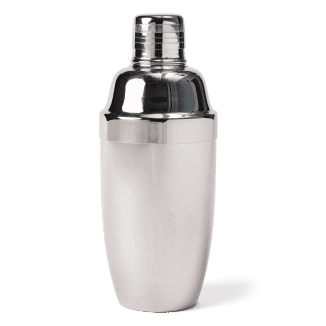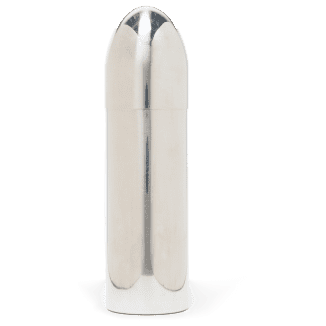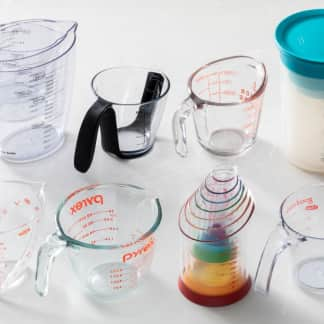The best cocktail shakers are easy to seal and open and let you shake, stir, and muddle drinks effectively. If you’re new to making cocktails, we recommend the Tovolo Stainless Steel 4-in-1 Cocktail Shaker. Its unconventional looks may not be for everyone, but it’s the easiest cocktail shaker for any novice bartender to use. If you’d like a more classic-looking cobbler shaker, we also recommend the Yukiwa Stainless Steel Jumbo Cobbler Cocktail Shaker. It’s handsome and seals tightly, though it can sometimes be a bit tricky to unseal once cold. Our favorite Boston shaker is the Houdini by Rabbit 24oz Stainless Steel & Glass Boston Cocktail Shaker. This inexpensive, easy-to-clean option takes some experience to use properly but is failproof once you do.

A good cocktail shaker lets you make and serve drinks quickly, easily, and with the panache and flair required of the occasion. Functionally, its job is to help you hold, chill, and dilute your drink ingredients so that you have a well-balanced, tasty cocktail by the time you’re done stirring or shaking it.
There are several different types of cocktail shaker, but two are most common: the Boston shaker and the cobbler shaker.

A Boston shaker consists of two tumblers of slightly different sizes. The larger tumbler is always made of stainless steel, and the smaller one can either be stainless steel or glass. You can build and stir or muddle cocktails in either tumbler. To shake a cocktail in a Boston shaker, you invert the smaller tumbler into the larger one at a slight angle, tap the two together firmly to create a tight seal, shake, unseal, and use a separate Hawthorne strainer to decant the mixture into a serving glass.

A cobbler shaker usually has three parts: a bottom half, a top half with a built-in strainer, and a cap that fits over the open strainer. As with the Boston shaker, you build, stir, and muddle cocktails in the bottom half. To shake a cocktail in a cobbler shaker, you add your ingredients to the bottom half and then fit on the strainer top, cap it, shake, uncap, and decant the drink through the strainer top.
To find the best cocktail shaker in each style for the home bartender, we bought a variety of Boston and cobbler shakers and used them to make shaken, stirred, and muddled drinks. Because we wanted to be able to make one or two cocktails at a time, we focused on models with a capacity of at least 18 ounces.
Should You Get a Cobbler Shaker or a Boston Shaker?
Cobbler shakers are arguably the more attractive tools to use for making and serving drinks—they’re a little fancier-looking, helping you set the mood for your cocktail experience. (They are beloved by many bartenders in high-end settings for this reason.)
In theory, cobbler shakers also offer ease of use and convenience for novice bartenders—because the strainer is built in and the other parts just join together, no extra gear or expertise is seemingly required to use them. In practice, however, they can actually be a little trickier to use than they first appear.
Our big issue? The top and the bottom of the cobbler shakers don’t always fit together properly, making most of these models a pain to handle. A few of the models had strainer tops that were too loose, causing the shakers to leak or break apart during use. But most cobblers had the opposite problem: Their parts fit together too tightly, making them harder to open, especially after we’d shaken drinks and the cobblers were cold and wet. A few models stuck together so tenaciously that nothing we did could un-stick them, despite trying every trick in the book.
In addition, although cobbler shakers come with a built-in strainer, the strainer holes are typically quite large, so you’ll still need a separate Hawthorne strainer or small fine-mesh strainer to ensure that no bigger chips of ice escape when pouring out your drink. And there are more finicky parts to clean and keep track of—the strainer cap can get lost easily, and herbs and citrus pulp can get stuck in the strainer if you don’t wash it quickly.
If you’re up for a little more of a challenge, we highly recommend trying a Boston shaker instead of a cobbler shaker. Boston shakers have a steeper learning curve—it takes a bit of practice to securely seal and unseal one. But many professional bartenders swear by them, and for good reasons: Used correctly, Boston shakers form leakproof seals more quickly and more reliably than most cobbler shakers and are easier to unseal as well. They have no small parts that get lost or stuck and are very simple to clean. Their simplicity makes them practically failproof; we’ve recommended every Boston shaker we’ve ever tested. And finally, they’re much less expensive than most cobbler shakers, though you’ll need to buy a Hawthorne strainer to hold back any ice when pouring your drink into a glass.
Good cobbler shakers and Boston shakers can both work well, so ultimately, the choice is yours. We recommend options in both styles so that you can decide whether you prefer a model that’s especially easy to use, stunning to look at, or simple and durable.
Regardless of type, a few characteristics made certain models better than others.

What to Look For
- Large Capacity: All the models we tested are big enough to make two drinks at a time, but we preferred those with slightly larger capacities of 24 ounces or more. Bigger shakers not only allow you to make more drinks at a time but also provide more room for ice and liquids to circulate, enabling you to chill and dilute your cocktail to the appropriate levels more quickly. (Dilution isn’t a bad word here; water takes the harsh edge off alcohol and acid, bringing balance to your cocktail and making it more palatable.)

- Wide Mouths: The bottom half of any shaker should be fairly wide across the top—at least 3 inches in diameter. Wider openings let you add plenty of ice and ingredients without having to be too careful about how you pour them in. We preferred shakers that tapered down from their wider openings, however; tumblers that were wide all the way down were harder for users with small hands to hold.
- Mixing Tumblers of Moderate Height: The bottom half of a shaker should be tall enough to hold ice and ingredients without them flying out when you stir drinks but not so tall that the walls prevent you from holding a standard barspoon securely. A height of about 5 to 7 inches was best.
- A Tight, Leakproof Seal: Used correctly, all the Boston shakers we tested seal tightly, preventing any liquid from getting out. By contrast, only some of the cobblers we tested had parts that fit together well enough to prevent leaks.
- Easy Unsealing or Opening: Again, when used properly, all Boston shakers are incredibly easy to open back up after shaking a cocktail. You just wiggle the top half a little to break the seal or gently tap the shaker at the point where the top half meets the bottom. Only some of the cobblers were easy to unseal or open; we preferred those that had tops that screwed onto the bottom halves, as they were generally easier to work with than those with tops that slid onto the bottoms.
- For Cobblers, Quick Decanting: We preferred cobbler shakers with strainers that had plenty of large holes, ensuring that we could pour out our drinks quickly.
- For Boston Shakers, Glass Halves: While you can’t go wrong with any Boston shaker, we slightly prefer Boston shakers that have a glass top half and a metal bottom to Boston shakers that have metal tops and bottoms. Glass-and-metal Boston shakers are a little heavier than all-metal variants, and there is some risk that the glass half can break if you drop it. But we found that the weight of the glass half helped it sink into the metal half a bit more readily, making for a tighter, more failproof seal. We also liked that we could see the ingredients more easily as we added them into the glass, making it a breeze to keep track of where we were in a cocktail formula. And we found glass-and-metal shakers a touch easier to hold and shake than all-metal versions. All-metal shakers of any kind can get very cold by the time your drink is ready. With a glass top half, your hands stay a little warmer, but you still get good sensory feedback from the colder metal half so you know when your drink is done.
What to Avoid
- Narrow Mouths: Shakers with narrow openings required a lot more care to add ice and ingredients without spilling.
- Leaky Seals: We strongly recommend against shakers that don’t seal properly; they sprayed liquid all over us when we shook them. And nothing is worse than a cocktail that never makes it into your glass.
- For Cobblers, Slow Decanting: Some cobbler shakers had strainers that were too small and/or had too few holes, so it took forever to pour drinks into glasses.
Other Considerations
- Insulated Shakers: Insulated shakers seem like a good idea—they keep your hands from getting cold as you shake drinks. The problem is, they’re less effective at chilling and diluting your drinks. Ordinarily, ice melts inside your shaker as it comes into contact with both the relatively warmer drink ingredients and the metal of the shaker, which draws heat from your hands and the air outside. You actually want ice to melt into your ingredients; this brings the overall temperature of the drink down so the drink is properly diluted. Insulated shakers keep the ice from receiving any heat from the metal, so the drink ingredients are the only things making the ice melt. As a result, it takes a lot longer and a lot more work to chill a drink in an insulated shaker. In addition, it’s harder to tell when your drink is properly chilled with an insulated shaker. With simple, uninsulated shakers, your hands will tell you when your drink is ready: the shaker itself will be ice-cold.
The Tests
- Fill to capacity, test for leakage and loose parts
- Make martinis
- Make mojitos
- Make Ramos gin fizzes, dry-shaking for 1 minute and shaking with ice for an additional minute
- Throughout, measure the temperature of the shaker exterior and the temperature and volume of the finished drink
- Test with users of different hand sizes and levels of cocktail-making experience
- Wash by hand or run through the dishwasher 10 times, testing for leaks after five and 10 washes
How We Rated
- Performance: We rated the shakers on how well we were able to chill and dilute drinks in them.
- Ease of Use: We rated the shakers on how easy they were to fill with ice, close, shake, and open; we also evaluated how easy it was to stir and muddle in them.
- Security: We gave more points to shakers that consistently formed tight, leakproof seals. We deducted points from shakers that had loose parts.
- Durability: We evaluated the shakers on how durable they were, preferring those that did not warp, retain water, or leak after 10 washes.




 Buy at Korin
Buy at Korin


 Buy at Williams Sonoma
Buy at Williams Sonoma











